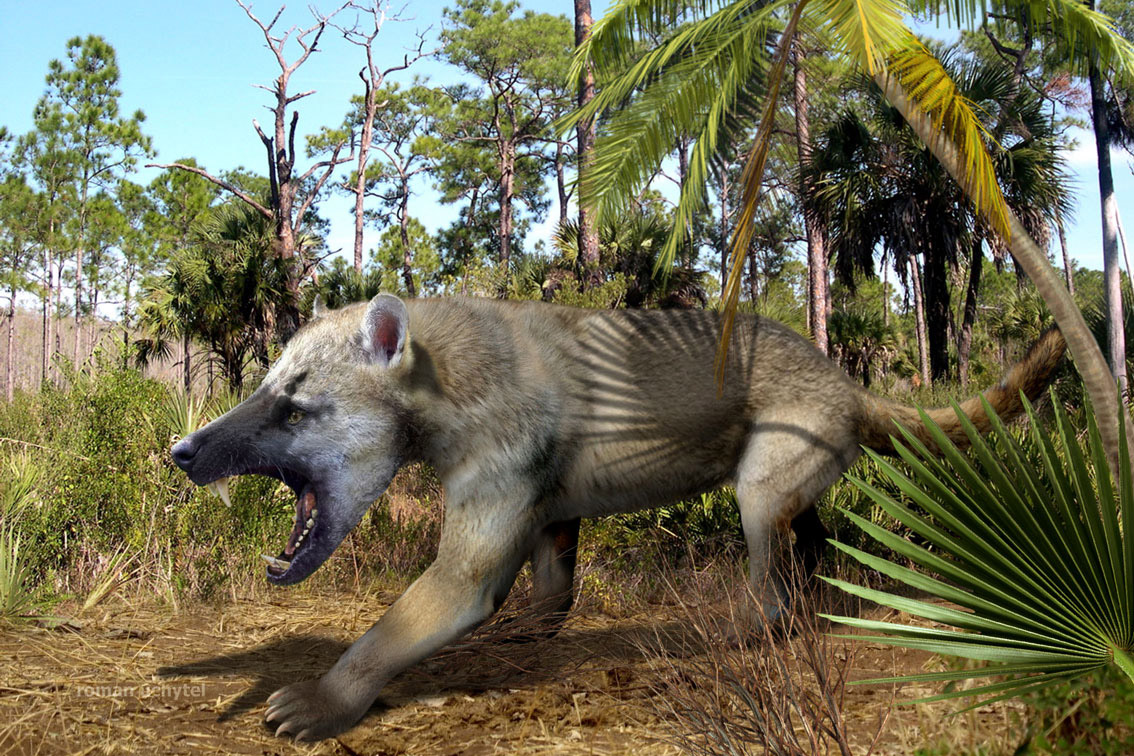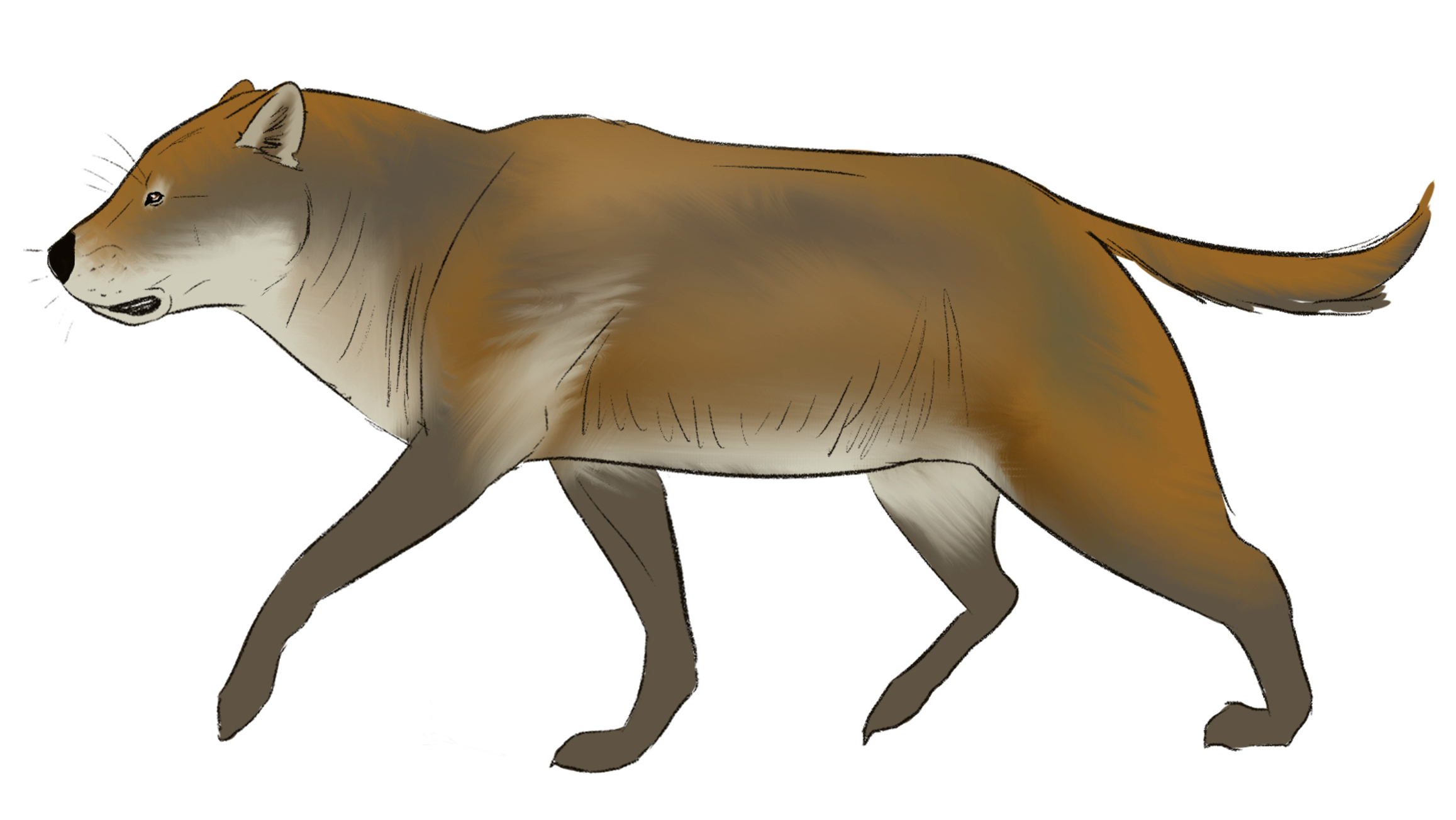|
Amphicyonid
Amphicyonidae is an extinct family of terrestrial carnivorans belonging to the suborder Caniformia. They first appeared in North America in the middle Eocene (around 45 mya), spread to Europe by the late Eocene (35 mya), and further spread to Asia and Africa by the early Miocene (23 mya). They had largely disappeared worldwide by the late Miocene (5 mya), with the latest recorded species at the end of the Miocene in Africa. They were among the first carnivorans to evolve large body size. Amphicyonids are colloquially referred to as "bear-dogs". Taxonomy The family was erected by Haeckel in 1866 (also attributed to Trouessart 1885). Their exact position has long been disputed. Early paleontologists usually defined them as members of Canidae (the dog family) or Ursidae (the bear family), but the modern consensus is that they form their own family. Some researchers have defined it as the sister clade to ursids, based on morphological analysis of the ear region. However, cladistic a ... [...More Info...] [...Related Items...] OR: [Wikipedia] [Google] [Baidu] |
Daphoenus Vetus Skull
''Daphoenus'' is an extinct genus of amphicyonids, a group colloquially known as "bear-dogs". It includes not just some of the best preserved material out of any amphicyonid, but also the earliest members of the family, first appearing in the Eocene, middle Eocene and surviving into the Rupelian, Early Oligocene. The members of the genus are rather small compared to some of its later relatives, such as ''Amphicyon'' or ''Ysengrinia'', ranging in size from comparable to a house cat to a small wolf. It was widely distributed across North America, with most of its remains being discovered in the White River Formation, White River Group of the Great Plains, though the John Day Beds of Oregon and the Cypress Hills Formation in Saskatchewan also represent important fossil sites. Other specimens have been described from localities in Texas, Georgia (country), Georgia, Florida, and California. Taxonomy The first fossils of ''Daphoenus vetus'' were collected by John Evans in 1849, befor ... [...More Info...] [...Related Items...] OR: [Wikipedia] [Google] [Baidu] |
Thaumastocyoninae
Thaumastocyoninae is an extinct subfamily of amphicyonids, large terrestrial carnivores, which inhabited what is now Europe during the Miocene epoch. The subfamily was erected by Hürzeler (1940), and is defined by the complete suppression of m1 metaconid, reduction of the premolars, except the p4, which is reinforced, and the oblique abrasion of the teeth, and the possession of hypercarnivorous tendencies. Thaumastocyonines are poorly known, with only about 65 dental specimens, most of those isolated teeth, being known as of 2020,Morlo M, Bastl K, Habersetzer J, Engel T, Lischewsky B, Lutz H, von Berg A, Rabenstein R, Nagel D. 2020The apex of amphicyonid hypercarnivory: solving the riddle of ''Agnotherium antiquum'' Kaup, 1833 (Mammalia, Carnivora).Journal of Vertebrate Paleontology 39(5):e1705848 DOI 10.1080/02724634.2019.1705848. although more complete remains have recently been discovered. Evolution and phylogeny The first thaumastocyonines appear during the earliest Miocen ... [...More Info...] [...Related Items...] OR: [Wikipedia] [Google] [Baidu] |
Amphicyoninae
Amphicyoninae is a subfamily of extinct amphicyonids, large Terrestrial animal, terrestrial carnivores sometimes called "bear-dogs", belonging to the suborder Caniformia, which inhabited North America, Eurasia, and Africa from the middle Eocene to the late Miocene. Amphicyoninae was first named by Trouessart (1885). It was assigned to Canidae by Matthew (1902), to Ursidae by Ginsburg (1977) and to Amphicyonidae by Hunt (1998). Genera include: *''Amphicyon'', found in both Europe and N. America *''Cynelos'', synonyms include ''Absonodaphoenus'' (from Florida) and ''Hecubides'' (from Africa), endemic to N. America *''Cynodictis'' *''Ischyrocyon'' (syn. ''Hadrocyon''), endemic to N. America *''Goupilictis'' *''Magericyon'' *''Paludocyon'' *''Pliocyon'', endemic to N. America *''Pseudocyon'' (syn. ''Amphicyonopsis''), endemic to Europe and N. America Fossil distribution Specimens have been recovered from: *Midway Site, Gadsden County, Florida ~18.9—18.8 Ma. *Rabbitt Creek S ... [...More Info...] [...Related Items...] OR: [Wikipedia] [Google] [Baidu] |
Temnocyoninae
The Temnocyoninae are an extinct subfamily of medium-sized amphicyonids endemic to North America that lived during the Early Oligocene to Early Miocene The Early Miocene (also known as Lower Miocene) is a sub-epoch of the Miocene epoch (geology), Epoch made up of two faunal stage, stages: the Aquitanian age, Aquitanian and Burdigalian stages. The sub-epoch lasted from 23.03 ± 0.05 annum, Ma to ... about 30.8-20.43 million years ago (Mya) existing for around 10 million years. References Amphicyonidae Oligocene caniforms Miocene carnivorans Aquitanian extinctions Prehistoric mammals of North America White River Fauna Oligocene first appearances {{paleo-carnivora-stub ... [...More Info...] [...Related Items...] OR: [Wikipedia] [Google] [Baidu] |
Arctocyonidae
Arctocyonidae (from Greek ''arktos'' and ''kyôn'', "bear/dog-like") is an extinct, possibly polyphyletic family of placental mammals which lived from the late Cretaceous to the early Eocene. They were initially regarded as creodonts, though have since been reassigned to an order of their own, the Arctocyonia. Some have suggested that arctocyonids are ancestral to modern-day artiodactyls, or that they form a sister group. However, more recent phylogenetic analyses suggest that arctocyonids may represent an artificial grouping of extinct ungulates, or that they might be an assemblage of unrelated placentals related to pangolins, pantodonts, and periptychids. Members of Arctocyonidae are characterised by long skulls, with large sagittal crests and very large canines. In the case of '' Arctocyon'' proper, the lower canines especially were large enough to require a diastema on the upper jaw to accommodate them. Arctocyonids varied considerably in size and morphology. Smaller gen ... [...More Info...] [...Related Items...] OR: [Wikipedia] [Google] [Baidu] |
Eocene
The Eocene ( ) is a geological epoch (geology), epoch that lasted from about 56 to 33.9 million years ago (Ma). It is the second epoch of the Paleogene Period (geology), Period in the modern Cenozoic Era (geology), Era. The name ''Eocene'' comes from the Ancient Greek (''Ēṓs'', 'Eos, Dawn') and (''kainós'', "new") and refers to the "dawn" of modern ('new') fauna that appeared during the epoch.See: *Letter from William Whewell to Charles Lyell dated 31 January 1831 in: * From p. 55: "The period next antecedent we shall call Eocene, from ήως, aurora, and χαινος, recens, because the extremely small proportion of living species contained in these strata, indicates what may be considered the first commencement, or ''dawn'', of the existing state of the animate creation." The Eocene spans the time from the end of the Paleocene Epoch to the beginning of the Oligocene Epoch. The start of the Eocene is marked by a brief period in which the concentration of the carbon isoto ... [...More Info...] [...Related Items...] OR: [Wikipedia] [Google] [Baidu] |
Hemicyoninae
Hemicyoninae is an extinct subfamily of Ursidae, often called dog bears (literally "half dog" (Ancient Greek, Greek: )). They were bear-like carnivorans living in Europe, North America, Africa and Asia during the Oligocene through Miocene epochs 33.9–5.3 Annum, Ma, existing for approximately . They are sometimes classified as a separate family (biology), family. Systematics The hemicyonines consists of three tribes: the Cephalogalini, Phoberocyonini, and Hemicyonini. In the past the hemicyonines were evaluated into family level (Hemicyonidae). However the vast majority of papers and researchers that cover the evolution of bears often classified them as an extinct subfamily of ursids or stem-bears. The genus ''Agriotherium'' was once classified as a hemicyonine but recent work has shown the genus is a crown-ursid. * Subfamily †Hemicyoninae Frick, 1926 ** Tribe †Cephalogalini de Bonis, 2013 *** †''Adelpharctos'' de Bonis, 1971 **** †''Adelpharctos ginsburgi'' de Bo ... [...More Info...] [...Related Items...] OR: [Wikipedia] [Google] [Baidu] |
Canidae
Canidae (; from Latin, ''canis'', "dog") is a family (biology), biological family of caniform carnivorans, constituting a clade. A member of this family is also called a canid (). The family includes three subfamily, subfamilies: the Caninae, and the extinct Borophaginae and Hesperocyoninae. The Caninae are known as canines, and include Dog, domestic dogs, Wolf, wolves, coyotes, raccoon dogs, Fox, foxes, jackals and other species. Canids are found on all continents except Antarctica, having arrived independently or accompanied by Human, human beings over extended periods of time. Canids vary in size from the gray wolf to the fennec fox. The body forms of canids are similar, typically having long muzzles, upright ears, teeth adapted for cracking bones and slicing flesh, long legs, and bushy tails. They are mostly social animals, living together in family units or small groups and behaving co-operatively. Typically, only the dominant pair in a group breeds and a litter of young ... [...More Info...] [...Related Items...] OR: [Wikipedia] [Google] [Baidu] |
Bear
Bears are carnivoran mammals of the family (biology), family Ursidae (). They are classified as caniforms, or doglike carnivorans. Although only eight species of bears are extant, they are widespread, appearing in a wide variety of habitats throughout most of the Northern Hemisphere and partially in the Southern Hemisphere. Bears are found on the continents of North America, South America, and Eurasia. Common characteristics of modern bears include large bodies with stocky legs, long snouts, small rounded ears, shaggy hair, plantigrade paws with five nonretractile claws, and short tails. While the polar bear is mostly carnivorous, and the giant panda is mostly herbivorous, the remaining six species are omnivorous with varying diets. With the exception of courtship display, courting individuals and mothers with their young, bears are typically solitary animals. They may be diurnality, diurnal or nocturnal and have an excellent sense of smell. Despite their heavy build and awk ... [...More Info...] [...Related Items...] OR: [Wikipedia] [Google] [Baidu] |
Hemicyonidae
Hemicyoninae is an extinct subfamily of Ursidae, often called dog bears (literally "half dog" (Ancient Greek, Greek: )). They were bear-like carnivorans living in Europe, North America, Africa and Asia during the Oligocene through Miocene epochs 33.9–5.3 Annum, Ma, existing for approximately . They are sometimes classified as a separate family (biology), family. Systematics The hemicyonines consists of three tribes: the Cephalogalini, Phoberocyonini, and Hemicyonini. In the past the hemicyonines were evaluated into family level (Hemicyonidae). However the vast majority of papers and researchers that cover the evolution of bears often classified them as an extinct subfamily of ursids or stem-bears. The genus ''Agriotherium'' was once classified as a hemicyonine but recent work has shown the genus is a crown-ursid. * Subfamily †Hemicyoninae Frick, 1926 ** Tribe †Cephalogalini de Bonis, 2013 *** †''Adelpharctos'' de Bonis, 1971 **** †''Adelpharctos ginsburgi'' de Bo ... [...More Info...] [...Related Items...] OR: [Wikipedia] [Google] [Baidu] |
Condylarthra
Condylarthra is an informal group – previously considered an order – of extinct placental mammals, known primarily from the Paleocene and Eocene epochs. They are considered early, primitive ungulates and is now largely considered to be a wastebasket taxon, having served as a dumping ground for classifying ungulates which had not been clearly established as part of either Perissodactyla or Artiodactyla, being composed thus of several unrelated lineages. Taxonomic history Condylarthra always was a problematic group. When first described by , Phenacodontidae was the type and only family therein. , however, raised Condylarthra to an order and included a wide range of diverse placentals with generalized dentitions and postcranial skeletons. More recent researchers (i.e. post-WW2) have been more restrictive; either including only a limited number of taxa, or proposing that the term should be abandoned altogether. Due to their primitive characteristics condylarths have been consi ... [...More Info...] [...Related Items...] OR: [Wikipedia] [Google] [Baidu] |
Amphicynodontidae
Amphicynodontidae is a probable clade of extinct arctoids. While some researchers consider this group to be an extinct subfamily of bears, a variety of morphological evidence links amphicynodontines with pinnipeds, as the group were semi-aquatic otter-like mammals. In addition to the support of the pinniped–amphicynodontine clade, other morphological and some molecular analyses support bears being the closest living relatives to pinnipeds. According to McKenna and Bell (1997) Amphicynodontinae are classified as stem-pinnipeds in the superfamily Phocoidea. Fossils of these mammals have been found in Europe, North America and Asia. Amphicynodontines should not be confused with Amphicyonids (bear-dogs), a separate family of Carnivora which is a sister clade to arctoids within the caniforms Caniformia is a suborder within the order Carnivora consisting of "dog-like" carnivorans. They include dogs (wolves, foxes, etc.), bears, raccoons, and mustelids. The Pinnipedia ( s ... [...More Info...] [...Related Items...] OR: [Wikipedia] [Google] [Baidu] |




